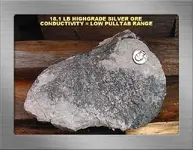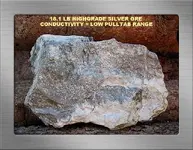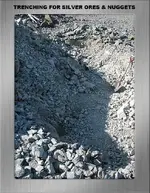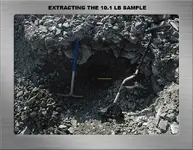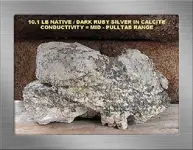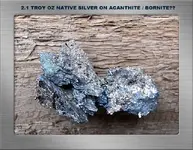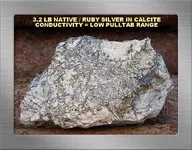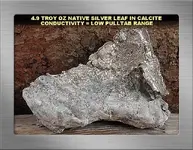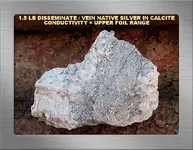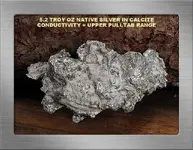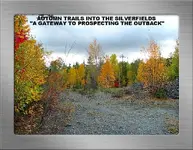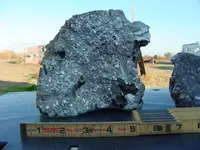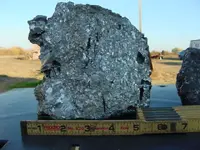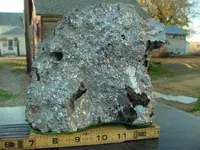Jim Hemmingway
Hero Member
Electronic Prospecting in Silver Country - Part 2
“A Discussion about Metal Detecting Silver Ores and Nuggets”
“A Discussion about Metal Detecting Silver Ores and Nuggets”
Introduction
This is the last of several articles about silver hunting that have been posted to the forum in recent years. While I hope everyone will see something interesting and enjoy the read, it is geared towards rockhounding enthusiasts involved with electronic prospecting for silver nuggets and ores. Many such people enjoy getting out for a day to prospect an abandoned minesite but that is about the extent of their participation within the hobby. What follows is designed to provide these hobbyists with some additional information about metal detecting and equipment selection specific to this application.
It has become more difficult to locate large multi-pound specimens that were somewhat commonplace years ago. But the silverfields continue to consistently supply good quantities of small silver to casual electronic prospectors despite searching easily accessible abandoned minesites. Some patience and physical effort is required to be successful, because many recoveries will be man-made ferrous and non-ferrous trash, and associated conductive minerals primarily in the form of sulfides and arsenides that respond to a metal detector.
Autumn is the preferred season to hunt for silver. The bugs are mostly gone and temperatures cool down such that we can comfortably search and dig targets. Autumn colors as depicted below are an additional benefit to what should be a non-competitive and relaxing experience.
As discussed briefly in last year’s article entitled “Electronic Prospecting in Silver Country” http://www.treasurenet.com/forums/canada/282315-electronic-prospecting-silver-country.html we’ll take another look at utilizing the “GROUNDGRAB / FASTGRAB” ground balance feature available on many current prospecting-capable VLF units as an additional tool to help determine target ID. While there is more to do, further evaluation of the technique with an F75 was done in the field this past autumn and that information will be presented later.
Silver Ores and Nuggets
The small silver specimen depicted in the photo below exemplifies the quality and typical size of native silver nuggets and specimens commonly recovered in silver country at the present time. This particular piece was found using the F75 in the motion all-metal mode, near maximum sensitivity http://www.treasurenet.com/forums/c...5-metal-detector-revised-february-2011-a.html with a ground balance setting at GB86 and a typical Fe3O4 bar graph magnetic susceptibility readout at 0.3% EM. That’s a bit tougher ground than a “moderate” designation would indicate but certainly is nothing extreme.
The strength of ground magnetic susceptibility should have little or no impact to one’s target recovery technique because overburden should always be removed until a strong signal and reliable target ID readout can be obtained. If in any doubt at all then you must dig the target. Otherwise disregard target ID over any but shallow targets with good strong signals because in these soil minerals silver can read as iron. On the other hand compact iron and larger high conductive iron such as drill rods and implements can and usually do read as silver even at modest depths.
The native silver ores and nuggets found here share a similar conductive range to gold, but we encounter greater numbers of higher conductive silver right up to and including the silver dime category. The majority of silver ores tend to reside within a category from foil to pulltab range. Silver ores may contain very pure native silver or the silver may be associated with a number of minerals common to the area. Those normally encountered by electronic prospectors include safflorite, cobaltite, niccolite, and skutterudite. And there are other substances associated with silver ores, for example a wide variety of sulfides and iron oxides, that may or not be detectable in the field but nonetheless frequently co-inhabit the same rocks as detectable native silver.
The specimen depicted below approaches the upper limit to what is described here as small silver when referring specifically to silver specimens rather than to silver nuggets. A three or four pound specimen is nothing unusual in the silverfields and is certainly nothing to be terribly excited about unless it’s an attractive ‘specimen quality’ piece.
Detector Selection
Which detector models are best suited for this application? I own several PI and VLF units to deal with variable field conditions and objectives. Field conditions refer to ferrous trash levels, the strength of ground mineral magnetic susceptibility, hotrock abundance, the physical site conditions and to the anticipated size and depth of the silver for which one intends to search.
For general scanning my usual preference is ground-balancing PI units… currently the Garrett Infinium and the White’s TDI Pro…and reasonably large searchcoils to improve depth and coverage where field conditions permit their use. Otherwise smaller PI searchcoils are a mainstay because they are more versatile over high-density target areas and rough terrain. The motion all-metal modes on VLF units that offer target ID… used in concert with quality headphones… perform well especially over more moderate magnetic susceptible iron minerals typical of many minesites here. I’ve explained in considerable detail my PI preferences for silver hunting in past articles posted to the forum. These can be located at http://www.treasurenet.com/forums/c...ntry-infinium-comparison-february-2011-a.html and at http://www.treasurenet.com/forums/c...erfields-ontario-revised-february-2011-a.html
Let’s have a look at the handsome “specimen grade” silver piece below, and then we’ll review some basic points to consider when selecting a ground-balancing PI unit for this application.
The primary reason for PI usage is to improve depth over VLF units in tough magnetic ground minerals. If one cannot achieve sufficient depth with a VLF unit to acquire deeper silver signals then all other VLF features or capabilities are of no consequence. The PI units I’ve selected also have a limited but very real ability to separate large and especially elongated iron from all silver ores and nuggets. The other main benefit of PI units is their ability to ignore most non-conductive iron mineralized hotrocks. However they do respond to conductive hotrocks such as the ever-present iron sulfide mineral pyrrhotite. Moreover, neither of these PI units can differentiate low conductive silver from low conductive ferrous trash. And that is precisely where the value of VLF target ID and discrimination features have an advantage over PI units in this area. At high trash sites PI operators can spend their days digging deep and shallow low conductive iron junk, and become frustrated with finding comparatively little or no silver.
But there are alternative search strategies with these units. One can flag PI target signals and recheck them with a VLF unit… thus eliminating the need to fully dig innumerable iron signals. Alternately, one can forget about using PI units in trashy areas and hunt exclusively with a VLF unit in the motion all-metal mode utilizing target ID effectively by removing overburden as described earlier. Another alternative in more severe trash areas is to search with a VLF unit employing a discrimination setting to eliminate most small iron signals. In such circumstances it is better to find some silver and avoid unnecessary digging and frustration dealing with countless blaring iron signals. In summary, it’s not difficult to understand why appropriate use of both PI and VLF units will improve our successful recovery of silver.
After viewing the attractive dendritic silver specimen below, we’ll discuss how the TDI Pro and Garrett Infinium are used for this application. The dendritic silver structure was not apparent in the field… in fact there was very little silver showing on the surface. Acid baths frequently expose native silver structure that surpasses our hopes or expectations as occurred in this instance… one of my favorites.
Review of the Infinium and TDI Pro for this Application
I tend to use the TDI Pro for specific tasks in this application, for example in high nail-infested areas, operating in the low conductive tone mode to capture low conductive silver ores while eliminating many of the nail signals. And silver ores are predominately low conductives. Silver hunting is a different ballgame from gold hunting insofar as silver normally comes in much larger sizes, and signals may be quite similar to larger iron…these are easily confused… particularly at depth. Compact large iron signals are very difficult to distinguish from silver ore signals, whereas as noted above… either unit is capable of identifying large elongated iron including larger nails at reasonably good depth.
The Infinium with its automated tones is quick and effective at differentiating elongated iron including nails from silver ores, and in zero discrimination will indicate compact iron such as drillbits, larger milling balls and other nondescript ‘chunky’ iron with a lo-hi tone. Only silver with conductivity at or above fringe zinc penny level will respond similarly and they are an infrequent occurrence. So we have a solid indication that the target is most likely iron and we can choose to ignore it at the risk of ignoring infrequently encountered high conductive silver. We can play the odds and those odds are very much in our favor. Alternately…we can check that target signal in reverse discrimination. If the signal changes to a hi-lo signal and particularly if the signal volume undergoes a serious reduction… we should dig it to avoid the possibility of losing any silver. It’s your choice based on useful indicative information. Most compact iron as described will change over to a hi-lo signal in reverse discrimination too, but it tends to retain most of its signal volume… and such iron is mostly what we encounter digging those signals.
By comparison the TDI Pro is not effective at indicating the identity of compact iron. With time-consuming GB control adjustments we can occasionally obtain a weak lo-hi-lo definitive iron tone in the all-conductive tone mode, but mostly that is not the case and we have to dig such signals. By and large it’s a waste of time and energy. Secondly…in the low conductive tone mode and properly ground-balanced the TDI Pro will ignore most nails but it does occasionally signal over larger elongated iron such as rail spikes and drillrods with either a good positive signal or a rather spurious signal…in part depending on the coil sweep direction. Now these can normally be identified with a lo-hi-lo tone and often without adjusting the GB control. But it means setting aside your pick, flipping the toggle into the all-conductive tone mode and sometimes adjusting the GB control to recheck such signals. Not a big deal but it takes additional time to manually check such signals and that time adds up over the course of each day.
The result of the above is that more ground can be covered with the Infinium’s automated tones and more effectively because some unnecessary digging in tough rocky substrates is avoided. So for general searching my preference is the Infinium. For this application I prefer to use the TDI Pro as a “niche” unit as described above. The Pro’s ability to eliminate signals from either high or low conductives permits searching trashy areas that otherwise would be difficult or impossible to properly search with the Infinium. The Pro is equipped with either my 10” elliptical mono or 5 ¼” round mono for this work… and combined with a very slow sweep speed really improve target separation over trashy ground while acquiring the best depth possible for those coils.
The photo below depicts what turned out to be a handsome “nuggety” silver specimen. It should have been field-cleaned prior to a photo… but nonetheless you can see the silver horns poking out beyond the dirt. Following the photo we’ll conclude this discussion with an illustrated side-by-side depth and sensitivity comparison of these units over freshly buried targets.
Operated at bare thresholds the TDI Pro is a noticeably deeperseeking and more sensitive unit. The Infinium’s depth / sens is improved by adjusting the threshold control up to 6ish or slightly more and adjusting headphone volume to preference. With this adjustment to Infinium…I see little or no difference between these units regarding depth / sensitivity over a variety of targets buried at variable depths in my testplot. There is some variability between different types and sizes of coils of course…we see that large coils tend to be deeperseeking on larger targets and less sensitive to shallower small stuff and vice-versa for small coils. Mono coils are deeperseeking compared to similar size DD coils in this moderately tough ground. Infinium’s mono coils are more likely to signal over high conductive large iron with an iron indicative lo-hi tone.
Now let’s look at some low conductive target responses presented in the chart below. As noted above, the majority of silver ores are low conductive. Keep in mind these depths do not represent the full capability of these units. Using solid lead “nuggets” instead of gold or silver nuggets, the fact that they’re freshly buried, and rather severe local EMI conditions… all contrive to reduce detection depth compared to silver nuggets in the field. But they do work just fine for relative side-by-side depth comparisons between these units. For this comparison, Infinium threshold is set to slightly above “6” at zero discrimination, with the GB locked. The TDI Pro is set to proper ground balance at GB9, maximum gain when possible, and a bare threshold. The chart designations indicate Weak, Fair, and Good signal responses.
I tend to compare the 8” Infinium round mono to the TDI designed Razorback 5 X 10” elliptical mono, and the Infinium 10” X 14” elliptical mono to the TDI Pro 12” DF round stock coil because these are comparable sizes. I think we can agree that the results are fairly close…the variances are likely due to the coils tested. While I see no significant advantage either way on these low conductive targets, the Infinium 8” round mono searchcoil performs best overall.
Review of VLF Units for this Application
Natural silver occurs in a comparatively large size, and in a wide conductive range… although the majority of silver is low conductive. It seems to me that VLF units operating in the mid-frequency range, such as MXT at 14 kHz or F75 at 13 kHz, are a good overall compromise. Lower operating frequencies also work for this application but may be slightly less sensitive to fringe depth low conductives. With the objective of coin-size and larger silver, I doubt it’s a terribly significant issue. But years of digging low conductive silver have sufficiently impressed me with mid-frequency units… particularly the F75… that these are my preference.
Mid-frequency range units are sensitive to both high and low conductors, and respond well to weaker signals produced by low conductive disseminated and sponge silver. Compared to high frequency units (a) they are less vulnerable to elevated magnetic susceptible ground minerals (b) see both higher conductive targets and larger targets at better depths and (c) have the advantage in this application of slightly less sensitivity to tiny bits and pieces. Keep in mind that silver is not gold, and we do not want to be distracted by tiny target signals.
There are many suitable mid-frequency VLF units currently available with variable feature sets. I don’t presume to advise anyone which model to purchase. Experience has shown me that any number of these units will perform well in the silverfields if operated competently. My preference includes features such as target ID in a threshold-based motion all-metal mode, a discrimination mode, a manually adjustable visually calibrated full range ground balance, a “fastgrab” ground balance for its convenience and to assist with target signal evaluation, and a decent selection of searchcoil types and sizes… all in a reasonably lightweight, well-balanced package.
The photo below is a small native silver nugget found a few years ago in mine tailings while using the F75. It’s a favorite find for nostalgic reasons, and serves a useful purpose here. It was the piece that firmly settled me into a comfort zone with the F75. At that time I viewed this unit as a questionable choice for this application. It had put me off in town with its invariable chattering in response to EMI when operated in discrimination modes at higher sensitivity settings. But I quickly learned that in remote prospecting environs it ran as quiet as a churchmouse at similar settings in any operating mode. And there’s nothing like finding a snootful of silver at good depth to form a long-term bond with a new unit.
VLF Searchcoil Selection, Type, and Size
Stock coil size on most units is normally quite sufficient for this application, but it doesn’t hurt to have a small “shooter” coil handy for tougher mineral ground, sites with abundant trash, and to facilitate searching jumbled tailings where coil maneuverability is an asset. Large coils are fine for lower trash density areas where ground minerals are not too harsh. Once popular with hobbyists for covering ground and ‘cherry-picking’ shallow silver, they’re infrequently seen these days. With target ID meters now available for the all-metal modes on many modern prospecting-capable detectors, most hunters seem content to go that route utilizing stock coils. They’re a good compromise in trashy tailings, handle ground minerals better than large coils, and have good depth and sensitivity to small and large silver.
Incidentally, pinpointers are highly effective in this application where all too frequently multiple signals exist in our diggings. My rugged Garrett Propointer is a real timesaver. Although I usually remember to keep my thumb over the speaker at such moments, it has been completely immersed in water countless times, has withstood repetitive severe digging abuse, and yet it still works just fine. And one nine-volt rechargeable battery lasted for an entire two-month season…the Propointer is a gem.
The photo below depicts another typical example of a small “specimen grade” silver ore found with the F75 at a popular collecting site readily accessible by car. Despite the lack of clarity in the photo, those darker areas represent silver at or just below the surface. You might think the large silver vein would increase the target ID conductivity, but I doubt the EMF even sees most of it due to “blocking” from adjacent “particulate” native silver structure.
When selecting a VLF searchcoil suitable for this application, the main factors to consider are iron trash abundance, the physical site conditions, and ground mineral magnetic susceptibility. We can’t change the search conditions so we must adapt our equipment and search technique to them. For example, you may plan to use a larger searchcoil to improve ground coverage and gain some additional detection depth. But nyet comrade, you find you’re unable to consistently keep the coil to its ground-balanced elevation over the ground due to surface irregularities, for example jumbled tailings. It results in distracting spurious ground signals. Unfortunately large coils see more ground mineral and react accordingly. You are faced with significant gain reductions to be able to continue searching with an unsuitably large coil. Alternately you may find that you are located at a high target density site where large coils are a poor choice. Signal evaluation is not possible when there are multiple targets under the coil. In either case a smaller searchcoil is warranted by site conditions that do not accommodate a large coil.
To reiterate, your best bet in most areas is to stick with the stock searchcoil and only make changes if the search conditions warrant or accommodate doing so. Ground coverage used to be a key strategy years ago when shallow quality silver was plentiful, but that is no longer the case at sites that have seen decades of collecting pressure. Electronic prospectors are well advised to take their time when searching… slow down and find more silver over the long haul. This strategy will enable you to hear and investigate very faint signals that are certain to net occasional multi-lb specimens at depth similar to the one below.
In summary… larger searchcoils cover more ground and are modestly deeperseeking on larger targets in moderate to light magnetic susceptible ground minerals. They lose sensitivity to small targets, and are more reactive to ground mineral effect. Small searchcoils cover less ground but are easier to stickhandle around rocks and bushes and maneuver into tight spaces, and are much lighter on the arm… a real benefit if hunting daily. They improve sensitivity to small silver and help with pinpointing what are normally hard-to-see targets covered in dirt. And yet even the small “shooter” coils have surprising depth for their size, while significantly reducing interference from ground minerals and dramatically reducing EMI. The smaller coils have plenty of attributes to recommend them even for this prospecting application.
Ground minerals do not affect DD searchcoils as much as same size and shape concentric searchcoils because DDs see significantly less ground, and this is visually evident in reduced GB and Fe3O4 readouts. A result is that at some level of magnetic susceptible ground mineral strength, DD searchcoils will surpass same size and shape concentric coils depthwise. But that rule doesn’t seem to apply to shooter coils. I see little difference between my 5” round DD and 6” elliptical concentric coil over any ground. In fact the 6” elliptical seems slightly more sensitive to buried small stuff… interesting for gold hunting… but not important here. Other DD benefits include wider sweep coverage and improved target separation compared to same size and shape concentrics… but they are more susceptible to EMI.
Despite the foregoing… my F75’s 10” elliptical concentric is normally my preference here. It’s considerably smaller, lighter and more maneuverable than the stock 11” DD coil, and any minor depth loss incurred usually takes a backseat to its attributes. It is more sensitive than the stock 11” DD in the all-metal motion mode, is more adept at target signal evaluation, and is a more reliable iron discriminator. Target signal evaluation is the one aspect of this application that warrants study, because there is a widespread proliferation of ferrous and non-ferrous trash, non-conductive and conductive hotrocks, and various minerals usually in the form of arsenides and sulfides that react to a metal detector. In some areas these can at times be overwhelming.
With that in mind, have a look at the high conductive silver specimen below, and then we’ll present some results from this past autumn using the GROUNDGRAB / FASTGRAB feature found on many modern prospecting-capable VLF units to assist with target signal evaluation.
FASTGRAB / GROUNDGRAB for Target Signal Evaluation
Last year’s article “Electronic Prospecting in Silver Country” introduced this subject with the comment that the GROUNDGRAB is accurate and convenient, and is an additional quick source of information when evaluating questionable signals. It makes searching hotrock areas properly ground-balanced in the all-metal motion mode more feasible because it takes only a moment to check out a suspect hotrock signal and then quickly re-balance to the ground and continue searching.
It was further noted that our positive diabase hotrocks read consistently in the upper iron range at target ID “14” on the F75. But when ground-balanced using the GROUNDGRAB / FASTGRAB technique they lose their positive signal, their target ID disappears, and there is always a small reduction in the ground balance readout. Other positive non-conductive iron-mineralized hotrock types in this area react similarly but experience more variable GB reductions.
Some preliminary observations were also reported on variable silver ore responses, reduced GB readouts on ferrous junk, and niccolite… a nickel arsenide. We confirmed this year that as anticipated… the technique is not definitive for many targets encountered in the field. But we did learn more about what can be expected and readers may find the results interesting.
Keep in mind these results were obtained using an F75 operated in the motion all-metal mode. Note that the F75’s FASTGRAB feature does not permit ground-balancing below GB40. This feature prevents the unit from tracking completely into metals. The manual ground balance must be used to compensate for ground with GB values more conductive than a GB40 setting.
The FASTGRAB / GROUNDGRAB technique is subject to a few conditions. (a) It applies only to targets buried in undisturbed ground. Other than non-conductive hotrocks it does not provide meaningful test results if done over targets placed on the ground’s surface. (b) The target must be accurately pinpointed prior to a fastgrab exactly over the pinpointed target signal. The issue is that all too often the subsurface is littered with all kinds of metallic debris and mineralized rock both large and small. These can play havoc with any attempt to acquire unequivocal fastgrab results, as do iron mineralized “hotspots” remaining from rusted and disseminated bits of iron. (c) Do not try and “brute force” the fastgrab by repeatedly pumping the coil over a target. It only takes three or four pumps to acquire accurate ground balance over clean ground, so we never exceed five pumps over a target. The concept is to permit the unit to make the decision about whether or not it will track into a target and by how much. (d) It’s not a condition but I do prefer the F75’s 10” elliptical concentric to the stock 11” DD coil for this work. It seems better able to retain the positive portion of a signal as you sweep a “fastgrabbed” conductive ore or metal target that the DD tends to want to attenuate into more of a negative hotrock “boing” or “twangy” type signal. It’s not a big deal and in some cases you hear little or no difference between coil types. But experience tells me the concentric coil is more consistent in preserving a positive signal over conductive targets.
The first photo is self-explanatory. Low-grade conductive pyrrhotite tends to reduce the ground balance readout variably from the GB40s well into the less conductive GB70s. These weak strength conductive hotrocks sometimes lose their signal similar to non-conductive positive hotrocks. More typical higher-grade pyrrhotite keeps its signal but the ground balance readout almost invariably drops into the GB40s as illustrated in the photo.
Much of the rusted iron junk dropped the ground balance into the GB40s. The large rusty nail results below are typical. Smaller bits and pieces of nails or whatever were more variable and could read higher on the GB scale. The questionable iron targets were large iron such as drill bits and rods or implements. If these were shallow strong signals, the unit would not usually track into them. There was no choice but to dig these signals after removing overburden if they consistently read above the iron target ID range.
On the same items but deeper… the unit was much more likely to track into them yielding similar GB results to those in the photo below. But as a rule of thumb, rusty iron responded to the fastgrab with sharply reduced ground balance readouts. A good many of these dropped into the GB40s and they retained their positive signals.
Most pristine silver… that is to say silver ores without any visually obvious associated cobalt or niccolite minerals… did not track downwards more than seven or eight points over most of the two month trip. In fact most of it remained virtually unchanged as illustrated with the silver in the photo below. But near the end of the trip several silver ores were recovered at one site that looked free of other minerals, yet the fastgrab GB dropped by twenty points to the mid-GB60s. Checking the holes didn’t reveal any obvious mineral staining or other material that might account for this result.
Other items, for example blasting caps, yield variable responses to the fastgrab technique. Occasionally the GB doesn’t react at all, but most blasting caps produce a steep ground balance reduction to the GB50 range and retain a positive signal. Cobalt and niccolite ores can react with sharp GB reductions but retain a positive signal. It seems to me that cobalt signals were more likely to produce GB reductions into the low GB40s. The signals from silver, iron junk, and other conductive ores are weakened to some extent when subjected to the FASTGRAB / GROUNDGRAB technique… some more than others. But regardless, all strictly silver signals checked this season retained a good positive signal.
In summary, this technique is an effective tool to distinguish non-conductive positive hotrocks from metal targets and most conductive ores because non-conductive positive hotrocks lose their signals and target ID. GB reductions are not consistent with all iron types and sizes, with all silver ores, or with other man-made trash such as blasting caps. Cobalt and niccolite dominant ores tend to overlap the iron GB reduction range. A result is that operators could ignore mixed ore samples that may or not contain some silver… if they rely exclusively on this technique for target signal evaluation.
More ore samples need to be checked at a wider variety of sites to be more definite about the results to date, but those results indicate strictly native silver samples do not groundgrab / fastgrab into the GB40s. Ground balance reductions into the GB40s have overwhelmingly been undesirable targets that are mostly iron trash. For example, dimes to doughnuts says that a target ID reading in the screwcap conductive range that experiences a GB40s fastgrab reduction is almost certain to be round or chunky or otherwise larger rusty iron.
Closing Remarks
Let’s conclude this write-up with an appreciative word about a new friend, Sheldon Ward. We became well acquainted while doing several hunts in the bush. As can be seen above, Sheldon generously put aside his own pursuits to volunteer his help with the “fastgrab project”. He is an accomplished silver hunter as evidenced by his knowledge and many beautiful silver finds.
The photo below depicts him with a 153 lb highgrade silver ore that he found recently with an F75 metal detector at a couple of feet depth. It has an impressive showing of native silver, reads at silver dime conductivity…that’s the maximum here… and is certainly museum quality.
That’s it… thanks to everyone for spending some time here. Comments are welcome. For newcomers to the hobby… no question is awkward or foolish… so don’t hesitate to ask it.
Jim Hemmingway
January 5, 2013
Amazon Forum Fav 👍
Last edited:
Upvote
0

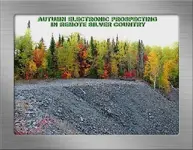
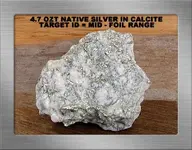
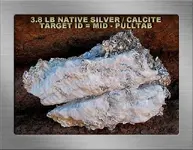
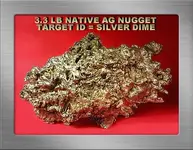
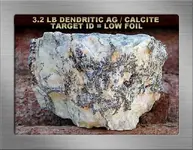
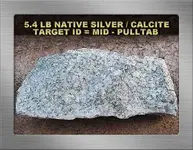
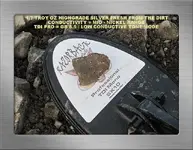
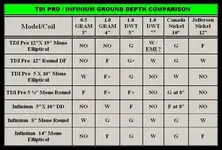
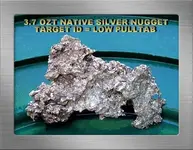
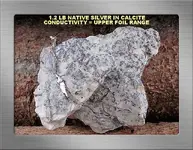
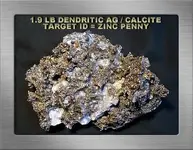
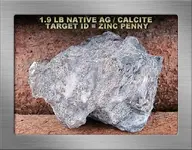
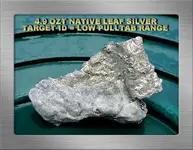
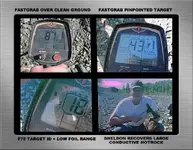
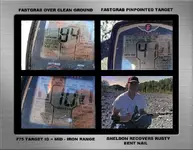
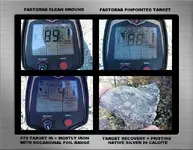





 I enjoy writing about this aspect of the hobby and reaching out to others in the prospecting fraternity.
I enjoy writing about this aspect of the hobby and reaching out to others in the prospecting fraternity. 